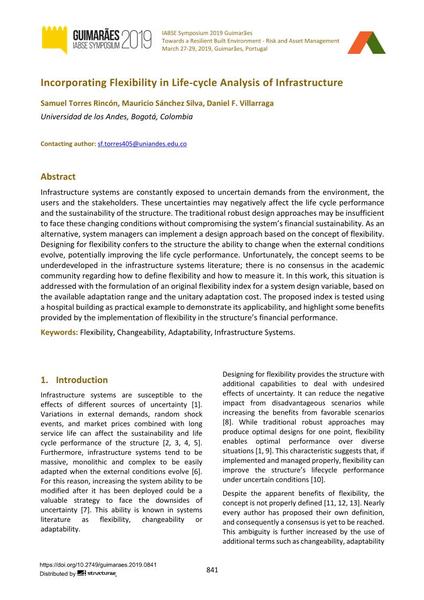Incorporating Flexibility in Life-cycle Analysis of Infrastructure

|
|
|||||||||||
Bibliografische Angaben
| Autor(en): |
Samuel Torres Rincón
(Universidad de los Andes, Bogotá, Colombia)
Mauricio Sánchez Silva (Universidad de los Andes, Bogotá, Colombia) Daniel F. Villarraga (Universidad de los Andes, Bogotá, Colombia) |
||||
|---|---|---|---|---|---|
| Medium: | Tagungsbeitrag | ||||
| Sprache(n): | Englisch | ||||
| Tagung: | IABSE Symposium: Towards a Resilient Built Environment Risk and Asset Management, Guimarães, Portugal, 27-29 March 2019 | ||||
| Veröffentlicht in: | IABSE Symposium Guimarães 2019 | ||||
|
|||||
| Seite(n): | 841-848 | ||||
| Anzahl der Seiten (im PDF): | 8 | ||||
| DOI: | 10.2749/guimaraes.2019.0841 | ||||
| Abstrakt: |
Infrastructure systems are constantly exposed to uncertain demands from the environment, the users and the stakeholders. These uncertainties may negatively affect the life cycle performance and the sustainability of the structure. The traditional robust design approaches may be insufficient to face these changing conditions without compromising the system’s financial sustainability. As an alternative, system managers can implement a design approach based on the concept of flexibility. Designing for flexibility confers to the structure the ability to change when the external conditions evolve, potentially improving the life cycle performance. Unfortunately, the concept seems to be underdeveloped in the infrastructure systems literature; there is no consensus in the academic community regarding how to define flexibility and how to measure it. In this work, this situation is addressed with the formulation of an original flexibility index for a system design variable, based on the available adaptation range and the unitary adaptation cost. The proposed index is tested using a hospital building as practical example to demonstrate its applicability, and highlight some benefits provided by the implementation of flexibility in the structure’s financial performance. |
||||
| Stichwörter: |
Flexibilität
|
||||
